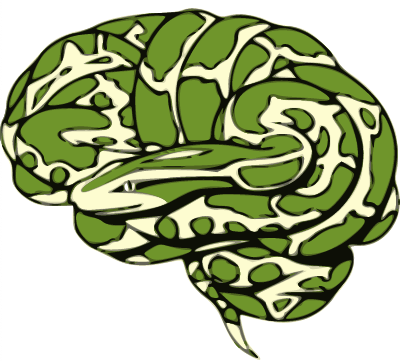Functional connectivity and resting state¶
Functional connectivity and resting-state data can be studied in many different way. Nilearn provides tools to construct “connectomes” that capture functional interactions between regions or to extract regions and networks, via resting-state networks or parcellations. For a much more detailed guide, go to Nilearn’s Connectivity section, here we want to show you just a few basics.
Speaking of which, we will be covering the following sections:
Extracting times series to build a functional connectome
Single subject maps of seed-to-voxel correlation
Single subject maps of seed-to-seed correlation
Group analysis of resting-state fMRI with ICA (CanICA)
Setup¶
Before we start with anything, let’s set up the important plotting functions:
from nilearn import plotting
%matplotlib inline
import matplotlib.pyplot as plt
import numpy as np
import pandas as pd
from nilearn import image
Also, let’s specify which subjects we want to use for this notebook. So, who do we have?
!nib-ls /data/adhd/*/*.nii.gz
/data/adhd/0010042/0010042_rest_tshift_RPI_voreg_mni.nii.gz int16 [ 61, 73, 61, 90] 3.00x3.00x3.00x2.00
/data/adhd/0010064/0010064_rest_tshift_RPI_voreg_mni.nii.gz int16 [ 61, 73, 61, 90] 3.00x3.00x3.00x2.00
/data/adhd/0010128/0010128_rest_tshift_RPI_voreg_mni.nii.gz int16 [ 61, 73, 61, 90] 3.00x3.00x3.00x2.00
/data/adhd/0021019/0021019_rest_tshift_RPI_voreg_mni.nii.gz int16 [ 61, 73, 61, 90] 3.00x3.00x3.00x2.00
/data/adhd/0027018/0027018_rest_tshift_RPI_voreg_mni.nii.gz int16 [ 61, 73, 61, 90] 3.00x3.00x3.00x1.96
/data/adhd/0027034/0027034_rest_tshift_RPI_voreg_mni.nii.gz int16 [ 61, 73, 61, 90] 3.00x3.00x3.00x1.96
/data/adhd/0027037/0027037_rest_tshift_RPI_voreg_mni.nii.gz int16 [ 61, 73, 61, 90] 3.00x3.00x3.00x1.96
/data/adhd/1517058/1517058_rest_tshift_RPI_voreg_mni.nii.gz int16 [ 61, 73, 61, 90] 3.00x3.00x3.00x2.00
/data/adhd/1562298/1562298_rest_tshift_RPI_voreg_mni.nii.gz int16 [ 61, 73, 61, 90] 3.00x3.00x3.00x2.00
/data/adhd/2497695/2497695_rest_tshift_RPI_voreg_mni.nii.gz int16 [ 61, 73, 61, 90] 3.00x3.00x3.00x2.00
/data/adhd/2950754/2950754_rest_tshift_RPI_voreg_mni.nii.gz int16 [ 61, 73, 61, 90] 3.00x3.00x3.00x2.00
/data/adhd/3007585/3007585_rest_tshift_RPI_voreg_mni.nii.gz int16 [ 61, 73, 61, 90] 3.00x3.00x3.00x1.96
/data/adhd/3520880/3520880_rest_tshift_RPI_voreg_mni.nii.gz int16 [ 61, 73, 61, 90] 3.00x3.00x3.00x2.00
/data/adhd/3994098/3994098_rest_tshift_RPI_voreg_mni.nii.gz int16 [ 61, 73, 61, 90] 3.00x3.00x3.00x2.00
/data/adhd/4134561/4134561_rest_tshift_RPI_voreg_mni.nii.gz int16 [ 61, 73, 61, 90] 3.00x3.00x3.00x1.96
/data/adhd/6115230/6115230_rest_tshift_RPI_voreg_mni.nii.gz int16 [ 61, 73, 61, 90] 3.00x3.00x3.00x1.96
/data/adhd/8409791/8409791_rest_tshift_RPI_voreg_mni.nii.gz int16 [ 61, 73, 61, 90] 3.00x3.00x3.00x1.96
/data/adhd/8697774/8697774_rest_tshift_RPI_voreg_mni.nii.gz int16 [ 61, 73, 61, 90] 3.00x3.00x3.00x2.00
/data/adhd/9744150/9744150_rest_tshift_RPI_voreg_mni.nii.gz int16 [ 61, 73, 61, 90] 3.00x3.00x3.00x2.00
/data/adhd/9750701/9750701_rest_tshift_RPI_voreg_mni.nii.gz int16 [ 61, 73, 61, 90] 3.00x3.00x3.00x2.00
For each subject we also have a regressor file, containing important signal confounds such motion parameters, compcor components and mean signal in CSF, GM, WM, Overal. Let’s take a look at one of those regressor files:
import pandas as pd
pd.read_table('/data/adhd/0010042/0010042_regressors.csv').head()
| csf | constant | linearTrend | wm | global | motion-pitch | motion-roll | motion-yaw | motion-x | motion-y | motion-z | gm | compcor1 | compcor2 | compcor3 | compcor4 | compcor5 | |
|---|---|---|---|---|---|---|---|---|---|---|---|---|---|---|---|---|---|
| 0 | 12140.708282 | 1.0 | 0.0 | 9322.722489 | 9955.469315 | -0.0637 | 0.1032 | -0.1516 | -0.0376 | -0.0112 | 0.0840 | 10617.938409 | -0.035058 | -0.006713 | -0.071532 | 0.009847 | -0.027601 |
| 1 | 12123.146913 | 1.0 | 1.0 | 9314.257684 | 9947.987176 | -0.0708 | 0.0953 | -0.1562 | -0.0198 | 0.0021 | 0.0722 | 10611.036827 | -0.026949 | -0.091152 | -0.030126 | 0.020055 | -0.099798 |
| 2 | 12085.963127 | 1.0 | 2.0 | 9319.610045 | 9945.132852 | -0.0795 | 0.0971 | -0.1453 | -0.0439 | -0.0241 | 0.0972 | 10591.877177 | 0.002552 | 0.069165 | 0.090166 | -0.016608 | -0.071980 |
| 3 | 12109.299348 | 1.0 | 3.0 | 9299.841075 | 9943.648622 | -0.0607 | 0.0918 | -0.1601 | -0.0418 | -0.0133 | 0.0877 | 10592.008336 | 0.079391 | 0.029959 | -0.098036 | 0.062493 | 0.024105 |
| 4 | 12072.330305 | 1.0 | 4.0 | 9297.870869 | 9925.640852 | -0.0706 | 0.0873 | -0.1482 | -0.0313 | -0.0118 | 0.0712 | 10570.445905 | 0.075471 | -0.030123 | 0.084739 | 0.088217 | 0.012996 |
So let’s create two lists, containing the path to the resting-state images and confounds of all subjects:
cp -R /data/adhd/ /home/neuro/workshop/notebooks/.
# Which subjects to consider
sub_idx = ['0010042', '0010064', '0010128', '0021019', '0027018',
'0027034', '0027037', '1517058', '1562298', '2497695',
'2950754', '3007585', '3520880', '3994098', '4134561',
'6115230', '8409791', '8697774', '9744150', '9750701']
# Path to resting state files
rest_files = ['/data/adhd/%s/%s_rest_tshift_RPI_voreg_mni.nii.gz' % (sub, sub) for sub in sub_idx]
# Path to counfound files
confound_files = ['/data/adhd/%s/%s_regressors.csv' % (sub, sub) for sub in sub_idx]
Perfect, now we’re good to go!
1. Extracting times series to build a functional connectome¶
So let’s start with something simple: Extracting activation time series from regions defined by a parcellation atlas.
Brain parcellation¶
As a first step, let’s define the regions we want to extract the signal from. For this we can use nilearn’s great “dataset” function. How about the Harvard-Oxford Atlas? At first, we download the atlas and corresponding data via the fetch_atlas_harvard_oxford. Please note that we will use the default version but one can also specify the probabilities and resolution.
from nilearn import datasets
atlas_ho = datasets.fetch_atlas_harvard_oxford('cort-maxprob-thr25-2mm')
Now we can access the atlas from the downloaded dataset:
# Location of HarvardOxford parcellation atlas
atlas_file = atlas_ho.maps
# Visualize parcellation atlas
plotting.plot_roi(atlas_file, draw_cross=False, annotate=False);
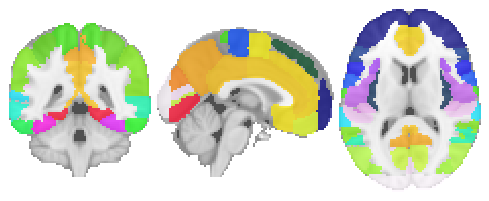
As mentioned above, the corresponding labels are also part of the dataset and can be accessed via:
# Load labels for each atlas region
labels = atlas_ho.labels[1:]
labels[:10]
['Frontal Pole',
'Insular Cortex',
'Superior Frontal Gyrus',
'Middle Frontal Gyrus',
'Inferior Frontal Gyrus, pars triangularis',
'Inferior Frontal Gyrus, pars opercularis',
'Precentral Gyrus',
'Temporal Pole',
'Superior Temporal Gyrus, anterior division',
'Superior Temporal Gyrus, posterior division']
Extracting signals on a parcellation¶
To extract signal on the parcellation, the easiest option is to use NiftiLabelsMasker. As any “maskers” in nilearn, it is a processing object that is created by specifying all the important parameters, but not the data:
from nilearn.input_data import NiftiLabelsMasker
masker = NiftiLabelsMasker(labels_img=atlas_file, standardize=True, verbose=1,
memory="nilearn_cache", memory_level=2)
The Nifti data can then be turned to time-series by calling the NiftiLabelsMasker fit_transform method, that takes either filenames or NiftiImage objects.
Let’s do this now for the first subject:
time_series = masker.fit_transform(rest_files[0], confounds=confound_files[0])
[NiftiLabelsMasker.fit_transform] loading data from /home/neuro/nilearn_data/fsl/data/atlases/HarvardOxford/HarvardOxford-cort-maxprob-thr25-2mm.nii.gz
Resampling labels
Compute and display the correlation matrix¶
Now we’re read to compute the functional connectome with ConnectivityMeasure.
from nilearn.connectome import ConnectivityMeasure
correlation_measure = ConnectivityMeasure(kind='correlation')
correlation_matrix = correlation_measure.fit_transform([time_series])[0]
And finally we can visualize this correlation matrix:
# Mask the main diagonal for visualization:
np.fill_diagonal(correlation_matrix, 0)
# Plot correlation matrix - note: matrix is ordered for block-like representation
plotting.plot_matrix(correlation_matrix, figure=(10, 8), labels=labels,
vmax=0.8, vmin=-0.8, reorder=True);
/opt/miniconda-latest/envs/neuro/lib/python3.7/site-packages/nilearn/plotting/matrix_plotting.py:17: MatplotlibDeprecationWarning:
The inverse_transformed function was deprecated in Matplotlib 3.3 and will be removed two minor releases later. Use transformed(transform.inverted()) instead.
ax.figure.transFigure).width
/opt/miniconda-latest/envs/neuro/lib/python3.7/site-packages/nilearn/plotting/matrix_plotting.py:25: MatplotlibDeprecationWarning:
The inverse_transformed function was deprecated in Matplotlib 3.3 and will be removed two minor releases later. Use transformed(transform.inverted()) instead.
ax.figure.transFigure).height
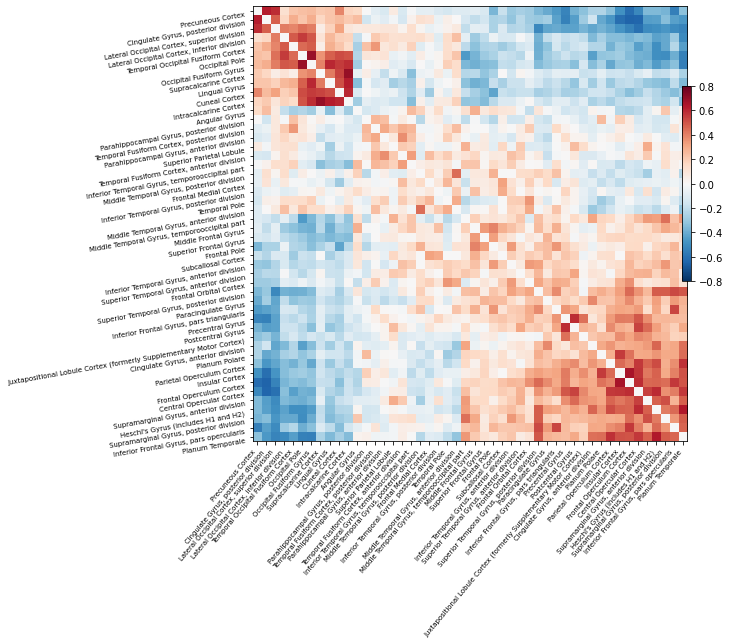
Same thing without confounds, to stress the importance of including confounds¶
Let’s do the same thing as before, but this time without using the confounds.
# Extract the signal from the regions
time_series_bad = masker.fit_transform(rest_files[0]) # Note that we haven't specify confounds here
# Compute the correlation matrix
correlation_matrix_bad = correlation_measure.fit_transform([time_series_bad])[0]
# Mask the main diagonal for visualization
np.fill_diagonal(correlation_matrix_bad, 0)
# Plot the correlation matrix
plotting.plot_matrix(correlation_matrix_bad, figure=(10, 8), labels=labels,
vmax=0.8, vmin=-0.8, title='No confounds', reorder=True)
[NiftiLabelsMasker.fit_transform] loading data from /home/neuro/nilearn_data/fsl/data/atlases/HarvardOxford/HarvardOxford-cort-maxprob-thr25-2mm.nii.gz
________________________________________________________________________________
[Memory] Calling nilearn.input_data.base_masker.filter_and_extract...
filter_and_extract('/data/adhd/0010042/0010042_rest_tshift_RPI_voreg_mni.nii.gz', <nilearn.input_data.nifti_labels_masker._ExtractionFunctor object at 0x7f9d251736d0>,
{ 'background_label': 0,
'detrend': False,
'dtype': None,
'high_pass': None,
'labels_img': '/home/neuro/nilearn_data/fsl/data/atlases/HarvardOxford/HarvardOxford-cort-maxprob-thr25-2mm.nii.gz',
'low_pass': None,
'mask_img': None,
'smoothing_fwhm': None,
'standardize': True,
'strategy': 'mean',
't_r': None,
'target_affine': None,
'target_shape': None}, confounds=None, dtype=None, memory=Memory(location=nilearn_cache/joblib), memory_level=2, verbose=1)
[NiftiLabelsMasker.transform_single_imgs] Loading data from /data/adhd/0010042/0010042_rest_tshift_RPI_voreg_mni.nii.gz
/opt/miniconda-latest/envs/neuro/lib/python3.7/site-packages/nilearn/input_data/base_masker.py:99: JobLibCollisionWarning: Cannot detect name collisions for function 'nifti_labels_masker_extractor'
memory_level=memory_level)(imgs)
WARNING:root:[MemorizedFunc(func=<nilearn.input_data.nifti_labels_masker._ExtractionFunctor object at 0x7f9d251736d0>, location=nilearn_cache/joblib)]: Clearing function cache identified by nilearn/input_data/nifti_labels_masker/nifti_labels_masker_extractor
[NiftiLabelsMasker.transform_single_imgs] Extracting region signals
________________________________________________________________________________
[Memory] Calling nilearn.input_data.nifti_labels_masker.nifti_labels_masker_extractor...
nifti_labels_masker_extractor(<nibabel.nifti1.Nifti1Image object at 0x7f9d251e4dd0>)
____________________________________nifti_labels_masker_extractor - 0.7s, 0.0min
[NiftiLabelsMasker.transform_single_imgs] Cleaning extracted signals
_______________________________________________filter_and_extract - 1.3s, 0.0min
/opt/miniconda-latest/envs/neuro/lib/python3.7/site-packages/nilearn/plotting/matrix_plotting.py:17: MatplotlibDeprecationWarning:
The inverse_transformed function was deprecated in Matplotlib 3.3 and will be removed two minor releases later. Use transformed(transform.inverted()) instead.
ax.figure.transFigure).width
/opt/miniconda-latest/envs/neuro/lib/python3.7/site-packages/nilearn/plotting/matrix_plotting.py:25: MatplotlibDeprecationWarning:
The inverse_transformed function was deprecated in Matplotlib 3.3 and will be removed two minor releases later. Use transformed(transform.inverted()) instead.
ax.figure.transFigure).height
<matplotlib.image.AxesImage at 0x7f9d22308190>
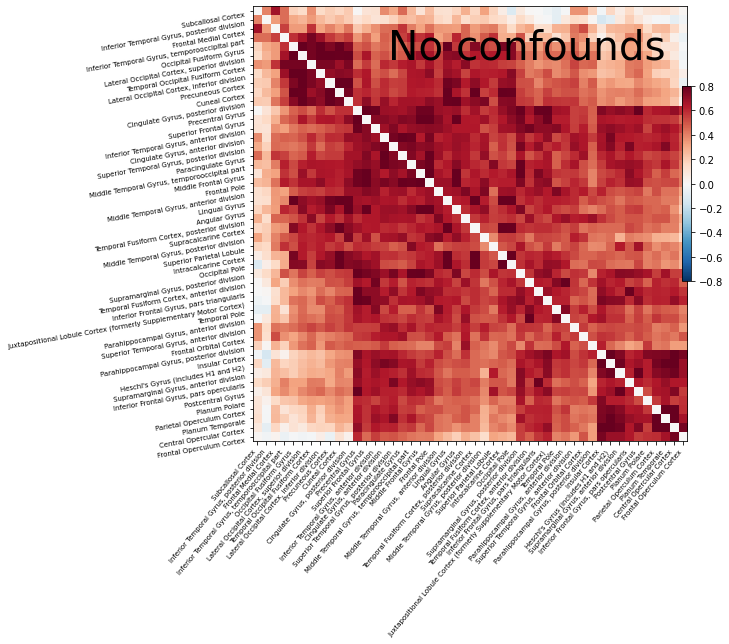
As you can see, without any confounds all regions are connected to each other! One reference that discusses the importance of confounds is Varoquaux & Craddock 2013.
Probabilistic atlas¶
Above we used a parcellation atlas. Now, with nilearn, you can do the same thing also with a probabilistic atlas. Let’s use for example the MSDL atlas.
# Path to MSDL atlas
msdl_atlas = datasets.fetch_atlas_msdl()
# Extract only default mode network nodes
dmn_nodes = image.index_img(msdl_atlas.maps, [3, 4, 5, 6])
# Plot MSDL probability atlas
plotting.plot_prob_atlas(dmn_nodes, cut_coords=(0, -60, 29), draw_cross=False,
annotate=False, title="DMN nodes in MSDL atlas")
/opt/miniconda-latest/envs/neuro/lib/python3.7/site-packages/numpy/lib/npyio.py:2372: VisibleDeprecationWarning: Reading unicode strings without specifying the encoding argument is deprecated. Set the encoding, use None for the system default.
output = genfromtxt(fname, **kwargs)
/opt/miniconda-latest/envs/neuro/lib/python3.7/site-packages/numpy/ma/core.py:2795: UserWarning: Warning: converting a masked element to nan.
order=order, subok=True, ndmin=ndmin)
<nilearn.plotting.displays.OrthoSlicer at 0x7f9d29cf58d0>
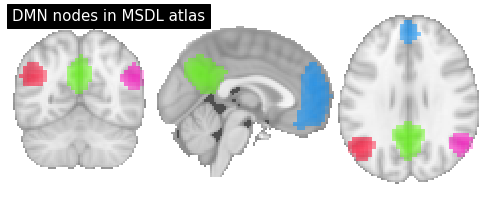
The only difference to before is that we now need to use the NiftiMapsMasker function to create the masker that extracts the time series:
from nilearn.input_data import NiftiMapsMasker
masker = NiftiMapsMasker(maps_img=msdl_atlas.maps, standardize=True, verbose=1,
memory="nilearn_cache", memory_level=2)
Now, as before
# Extract the signal from the regions
time_series = masker.fit_transform(rest_files[0], confounds=confound_files[0])
# Compute the correlation matrix
correlation_matrix= correlation_measure.fit_transform([time_series])[0]
# Mask the main diagonal for visualization
np.fill_diagonal(correlation_matrix, 0)
[NiftiMapsMasker.fit_transform] loading regions from /home/neuro/nilearn_data/msdl_atlas/MSDL_rois/msdl_rois.nii
Resampling maps
Before we plot the new correlation matrix, we also need to define the labels of the MSDL atlas. At the same time we will also get the coordinates:
# CSV containing label and coordinate of MSDL atlas
msdl_labels = msdl_atlas.labels
msdl_coords = msdl_atlas.region_coords
Perfect! Now as before, we can plot the correlation matrix as follows:
# Plot the correlation matrix
plotting.plot_matrix(correlation_matrix, figure=(10, 8), labels=msdl_labels,
vmax=0.8, vmin=-0.8, reorder=True)
/opt/miniconda-latest/envs/neuro/lib/python3.7/site-packages/nilearn/plotting/matrix_plotting.py:17: MatplotlibDeprecationWarning:
The inverse_transformed function was deprecated in Matplotlib 3.3 and will be removed two minor releases later. Use transformed(transform.inverted()) instead.
ax.figure.transFigure).width
/opt/miniconda-latest/envs/neuro/lib/python3.7/site-packages/nilearn/plotting/matrix_plotting.py:25: MatplotlibDeprecationWarning:
The inverse_transformed function was deprecated in Matplotlib 3.3 and will be removed two minor releases later. Use transformed(transform.inverted()) instead.
ax.figure.transFigure).height
<matplotlib.image.AxesImage at 0x7f9d235a4b50>
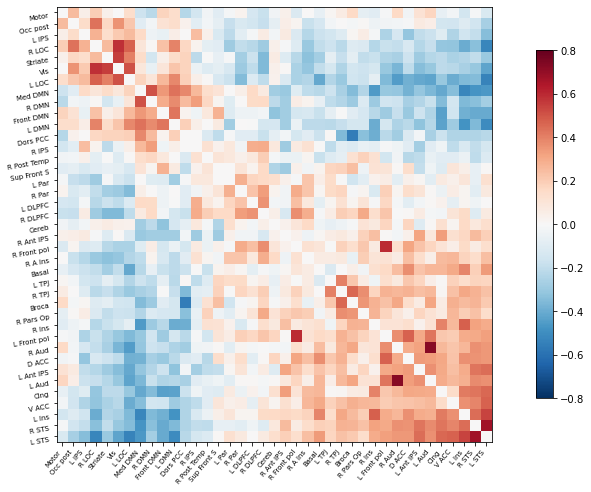
Display corresponding graph on glass brain¶
A square matrix, such as a correlation matrix, can also be seen as a “graph”: a set of “nodes”, connected by “edges”. When these nodes are brain regions, and the edges capture interactions between them, this graph is a “functional connectome”.
As the MSDL atlas comes with (x, y, z) MNI coordinates for the different regions, we can visualize the matrix as a graph of interaction in a brain. To avoid having too dense a graph, we represent only the 20% edges with the highest values. For another atlas this information can be computed for each region with the nilearn.plotting.find_xyz_cut_coords function:
plotting.plot_connectome(correlation_matrix, msdl_coords, edge_threshold="80%",
colorbar=True)
<nilearn.plotting.displays.OrthoProjector at 0x7f9d2343c7d0>
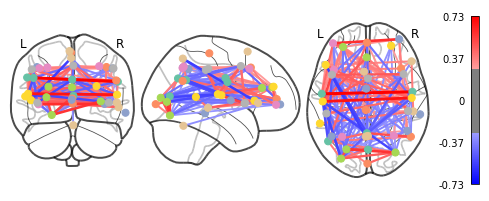
As you can see, the correlation matrix gives a very “full” graph: every node is connected to every other one. This is because it also captures indirect connections.
From version 0.5.0 on, nilearn also provides an interactive plot for connectoms:
plotting.view_connectome(correlation_matrix, msdl_coords, edge_threshold="80%", edge_cmap='bwr',
symmetric_cmap=True, linewidth=6.0, node_size=3.0)
2. Single subject maps of seed-to-voxel correlation¶
Above we computed the correlation between different regions. But what if we want to compute a seed-to-voxel correlation map for a single subject? The procedure is very similar to the one from before.
Time series extraction¶
First, we need to extract the time series from the seed region. For this example, let’s specify a sphere of radius 8 (in mm) located in the Posterior Cingulate Cortex. This sphere is considered to be part of the Default Mode Network.
# Sphere radius in mm
sphere_radius = 8
# Sphere center in MNI-coordinate
sphere_coords = [(0, -52, 18)]
In this case, we will use We use the NiftiSpheresMasker function to extract the time series within a given sphere. Before signal extraction, we can also directly detrend, standardize, and bandpass filter the data.
from nilearn.input_data import NiftiSpheresMasker
seed_masker = NiftiSpheresMasker(sphere_coords, radius=sphere_radius, detrend=True,
standardize=True, low_pass=0.1, high_pass=0.01,
t_r=2.0, verbose=1, memory="nilearn_cache", memory_level=2)
Now we’re read to extract the mean time series within the seed region, while also regressing out the confounds.
seed_time_series = seed_masker.fit_transform(rest_files[0], confounds=confound_files[0])
Next, we need to do a similar procedure for each voxel in the brain as well. For this, we can use the NiftiMasker, which the same arguments as before, plus additionally smoothing the signal with a smoothing kernel of 6mm.
from nilearn.input_data import NiftiMasker
brain_masker = NiftiMasker(smoothing_fwhm=6, detrend=True, standardize=True,
low_pass=0.1, high_pass=0.01, t_r=2., verbose=1,
memory="nilearn_cache", memory_level=2)
Now we can extract the time series for every voxel while regressing out the confounds:
brain_time_series = brain_masker.fit_transform(rest_files[0], confounds=confound_files[0])
[NiftiMasker.fit] Loading data from /data/adhd/0010042/0010042_rest_tshift_RPI_voreg_mni.nii.gz
[NiftiMasker.fit] Computing the mask
[NiftiMasker.fit] Resampling mask
Performing the seed-based correlation analysis¶
Now that we have two arrays (mean signal in seed region, signal for each voxel), we can correlate the two to each other. This can be done with the dot product between the two matrices.
Note, that the signals have been variance-standardized during extraction. To have them standardized to norm unit, we further have to divide the result by the length of the time series.
seed_based_correlations = np.dot(brain_time_series.T, seed_time_series)
seed_based_correlations /= seed_time_series.shape[0]
Plotting the seed-based correlation map¶
Finally, we can tranform the correlation array back to a Nifti image.
seed_based_correlation_img = brain_masker.inverse_transform(seed_based_correlations.T)
And this we can of course plot again to better investigate the correlation outcome:
display = plotting.plot_stat_map(seed_based_correlation_img, threshold=0.333,
cut_coords=sphere_coords[0])
display.add_markers(marker_coords=sphere_coords, marker_color='black',
marker_size=200)
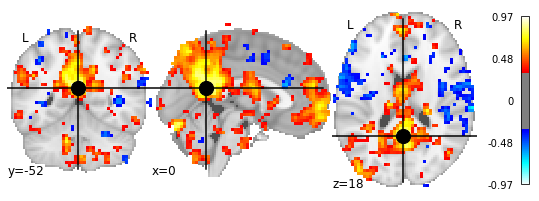
The map above depicts the temporal correlation of a seed region with the rest of the brain. For a similar example but on the cortical surface, see this example.
3. Single subject maps of seed-to-seed correlation¶
The next question is of course, how can compute the correlation between different seed regions? It’s actually very easy, even simpler than above.
Time series extraction¶
First, we need to extract the time series from the seed regions. So as before, we need to define a sphere radius and centers of the seed regions:
# Sphere radius in mm
sphere_radius = 8
# Sphere center in MNI-coordinate
sphere_center = [( 0, -52, 18),
(-46, -68, 32),
( 46, -68, 32),
( 1, 50, -5)]
Now we can extract the time series from those spheres:
# Create masker object to extract average signal within spheres
from nilearn.input_data import NiftiSpheresMasker
masker = NiftiSpheresMasker(sphere_center, radius=sphere_radius, detrend=True,
standardize=True, low_pass=0.1, high_pass=0.01,
t_r=2.0, verbose=1, memory="nilearn_cache", memory_level=2)
# Extract average signal in spheres with masker object
time_series = masker.fit_transform(rest_files[0], confounds=confound_files[0])
Display mean signal per sphere¶
If we want, we can even plot the average signal per sphere:
fig = plt.figure(figsize=(8, 4))
plt.plot(time_series)
plt.xlabel('Scan number')
plt.ylabel('Normalized signal')
plt.tight_layout();
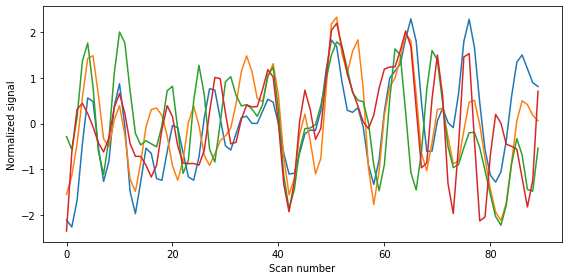
Compute partial correlation matrix¶
Now that we have the average signal per sphere we can compute the partial correlation matrix, using the ConnectivityMeasure function.
from nilearn.connectome import ConnectivityMeasure
connectivity_measure = ConnectivityMeasure(kind='partial correlation')
partial_correlation_matrix = connectivity_measure.fit_transform([time_series])[0]
# Plotting the partical correlation matrix
fig, ax = plt.subplots()
plt.imshow(partial_correlation_matrix, cmap='Spectral')
for (j,i),label in np.ndenumerate(partial_correlation_matrix):
ax.text(i, j, round(label, 2), ha='center', va='center', color='w')
ax.text(i, j, round(label, 2), ha='center', va='center', color='w')
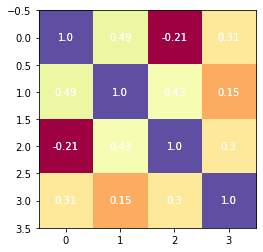
Display connectome¶
Now that we have the correlation matrix, we can also plot it again on the glass brain with plot_connectome:
from nilearn.plotting import plot_connectome
plot_connectome(partial_correlation_matrix, sphere_center,
display_mode='ortho', colorbar=True, node_size=150,
title="Default Mode Network Connectivity")
<nilearn.plotting.displays.OrthoProjector at 0x7f9d2243c2d0>
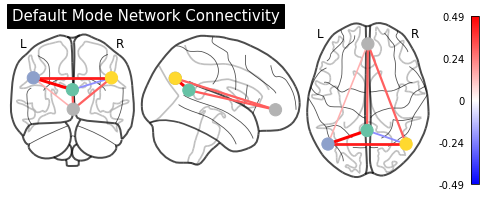
And again with nilearn’s interactive connectome viewer function:
plotting.view_connectome(partial_correlation_matrix, sphere_center, edge_cmap='bwr',
symmetric_cmap=True, linewidth=6.0, node_size=10.0)
4. Group analysis of resting-state fMRI with ICA (CanICA)¶
This section demonstrates the use of multi-subject Independent Component Analysis (ICA) of resting-state fMRI data to extract brain networks in a data-driven way. Here we use the CanICA approach, that implements a multivariate random effects model across subjects. Afterward this, we will also show a newer technique, based on dictionary learning.
Multi-subject ICA: CanICA¶
CanICA is a ready-to-use object that can be applied to multi-subject Nifti data, for instance, presented as filenames, and will perform a multi-subject ICA decomposition following the CanICA model.
from nilearn.decomposition import CanICA
# Number of components to extract
n_components = 20
# Creating the CanICA object
canica = CanICA(n_components=n_components,
smoothing_fwhm=6.,
threshold=3.,
random_state=0,
n_jobs=-1,
verbose=1)
As with every object in nilearn, we give its parameters at construction, and then fit it on the data.
canica.fit(rest_files)
[MultiNiftiMasker.fit] Loading data from [/data/adhd/0010042/0010042_rest_tshift_RPI_voreg_mni.nii.gz, /data/adhd/0010064/0010064_rest_tshift_RPI_voreg_mni.nii.gz, /data/adhd/0010128/0010128_rest_tshift_RPI_voreg_mni.nii.gz, /data/adhd/00210
[MultiNiftiMasker.fit] Computing mask
[MultiNiftiMasker.transform] Resampling mask
[CanICA] Loading data
[Parallel(n_jobs=-1)]: Using backend LokyBackend with 6 concurrent workers.
[Parallel(n_jobs=-1)]: Done 10 out of 10 | elapsed: 9.8s remaining: 0.0s
[Parallel(n_jobs=-1)]: Done 10 out of 10 | elapsed: 9.8s finished
CanICA(detrend=True, do_cca=True, high_pass=None, low_pass=None, mask=None,
mask_args=None, mask_strategy='epi', memory=Memory(location=None),
memory_level=0, n_components=20, n_init=10, n_jobs=-1, random_state=0,
smoothing_fwhm=6.0, standardize=True, t_r=None, target_affine=None,
target_shape=None, threshold=3.0, verbose=1)
Once CanICAhas finished we can retrieve the independent components directly in brain space.
components_img = canica.components_img_
Visualizing CanICA components¶
To visualize the components we can plot the outline of all components in one figure.
# Plot all ICA components together
plotting.plot_prob_atlas(components_img, draw_cross=False, linewidths=None,
cut_coords=[0, 0, 0], title='All ICA components');
/opt/miniconda-latest/envs/neuro/lib/python3.7/site-packages/nilearn/plotting/displays.py:99: UserWarning: No contour levels were found within the data range.
**kwargs)
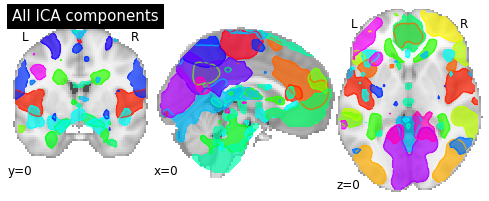
We can of course also plot the ICA components separately using the plot_stat_map and iter_img. Let’s plot the first few components:
# Extract first few components
first_few_comp = components_img.slicer[..., :4]
# Plot first few components
fig = plt.figure(figsize=(16, 3))
for i, cur_img in enumerate(image.iter_img(first_few_comp)):
ax = fig.add_subplot(1, 4, i + 1)
plotting.plot_stat_map(cur_img, display_mode="z", title="IC %d" % i,
cut_coords=1, colorbar=True, axes=ax)

Beyond ICA : Dictionary learning¶
Recent work has shown that dictionary learning based techniques outperform ICA in term of stability and constitutes a better first step in a statistical analysis pipeline. Dictionary learning in neuroimaging seeks to extract a few representative temporal elements along with their sparse spatial loadings, which constitute good extracted maps.
So let’s do the same thing again as above, but this time with DictLearning
# Import dictionary learning algorithm
from nilearn.decomposition import DictLearning
# Initialize DictLearning object
dict_learn = DictLearning(n_components=n_components,
smoothing_fwhm=6.,
random_state=0,
n_jobs=-1,
verbose=1)
Now we’re ready and can apply the dictionar learning object on the functional data:
# Fit to the data
dict_learn.fit(rest_files)
[MultiNiftiMasker.fit] Loading data from [/data/adhd/0010042/0010042_rest_tshift_RPI_voreg_mni.nii.gz, /data/adhd/0010064/0010064_rest_tshift_RPI_voreg_mni.nii.gz, /data/adhd/0010128/0010128_rest_tshift_RPI_voreg_mni.nii.gz, /data/adhd/00210
[MultiNiftiMasker.fit] Computing mask
[MultiNiftiMasker.transform] Resampling mask
[DictLearning] Loading data
[DictLearning] Learning initial components
[Parallel(n_jobs=-1)]: Using backend LokyBackend with 6 concurrent workers.
[Parallel(n_jobs=-1)]: Done 1 out of 1 | elapsed: 1.8s finished
[DictLearning] Computing initial loadings
[DictLearning] Learning dictionary
DictLearning(alpha=10, batch_size=20, detrend=True, dict_init=None,
high_pass=None, low_pass=None, mask=None, mask_args=None,
mask_strategy='epi', memory=Memory(location=None), memory_level=0,
method='cd', n_components=20, n_epochs=1, n_jobs=-1, random_state=0,
reduction_ratio='auto', smoothing_fwhm=6.0, standardize=True,
t_r=None, target_affine=None, target_shape=None, verbose=1)
As before, we can now retrieve the independent components directly in brain space.
components_img = dict_learn.components_img_
Visualizing DictLearning components¶
To visualize the components we can plot the outline of all components in one figure.
# Plot all ICA components together
plotting.plot_prob_atlas(components_img, draw_cross=False, linewidths=None,
cut_coords=[0, 0, 0], title='Dictionary Learning maps');
/opt/miniconda-latest/envs/neuro/lib/python3.7/site-packages/nilearn/plotting/displays.py:99: UserWarning: No contour levels were found within the data range.
**kwargs)
/opt/miniconda-latest/envs/neuro/lib/python3.7/site-packages/numpy/ma/core.py:2795: UserWarning: Warning: converting a masked element to nan.
order=order, subok=True, ndmin=ndmin)
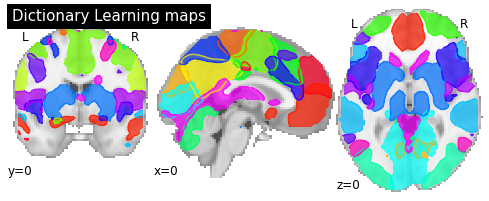
# Extract first few components
first_few_comp = components_img.slicer[..., :4]
# Plot first few components
fig = plt.figure(figsize=(16, 3))
for i, cur_img in enumerate(image.iter_img(first_few_comp)):
ax = fig.add_subplot(1, 4, i + 1)
plotting.plot_stat_map(cur_img, display_mode="z", title="IC %d" % i,
cut_coords=1, colorbar=True, axes=ax)

Compare ICA to DictLearning¶
Now let’s compare the two approaches by looking at some components:
plotting.plot_stat_map(canica.components_img_.slicer[..., 3], display_mode='ortho',
cut_coords=[45, -35, 50], colorbar=True, draw_cross=False,
title='CanICA component - Motor Cortex')
plotting.plot_stat_map(dict_learn.components_img_.slicer[..., 19], display_mode='ortho',
cut_coords=[45, -35, 50], colorbar=True, draw_cross=False,
title='DictLearning component - Motor Cortex')
<nilearn.plotting.displays.OrthoSlicer at 0x7f9d3398c2d0>
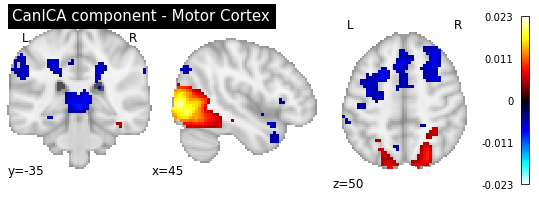
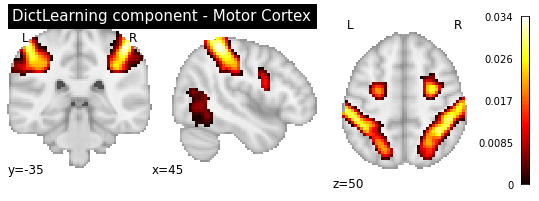
plotting.plot_stat_map(canica.components_img_.slicer[..., 16], display_mode='ortho',
cut_coords=[50, -15, 12], colorbar=True, draw_cross=False,
title='CanICA component - Auditory Cortex')
plotting.plot_stat_map(dict_learn.components_img_.slicer[..., 16], display_mode='ortho',
cut_coords=[50, -15, 12], colorbar=True, draw_cross=False,
title='DictLearning component - Auditory Cortex')
<nilearn.plotting.displays.OrthoSlicer at 0x7f9d33aca190>
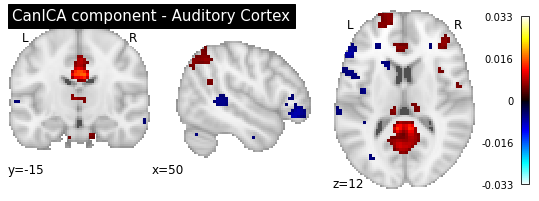
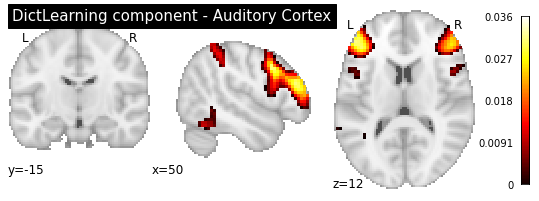
plotting.plot_stat_map(canica.components_img_.slicer[..., 0], display_mode='ortho',
cut_coords=[0, -75, 4], colorbar=True, draw_cross=False,
title='CanICA component - Visual Cortex')
plotting.plot_stat_map(dict_learn.components_img_.slicer[..., 3], display_mode='ortho',
cut_coords=[0, -75, 4], colorbar=True, draw_cross=False,
title='DictLearning component - Visual Cortex')
<nilearn.plotting.displays.OrthoSlicer at 0x7f9d20167fd0>
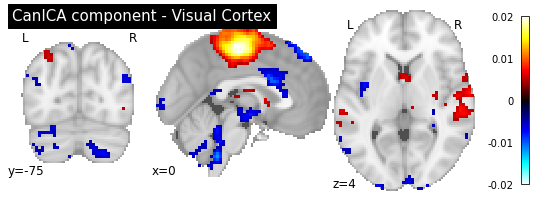
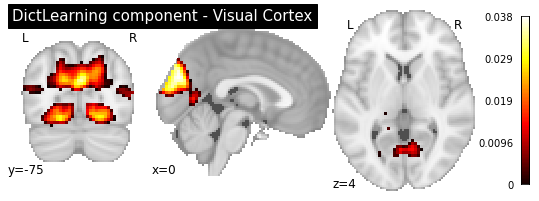
As you can see, the CanICA components looks much more noise, while the DictLearning components look sparser and more blobby. This becomes even more striking when we look at the corresponding glass brain plot:
plotting.plot_glass_brain(canica.components_img_.slicer[..., 16], black_bg=True,
plot_abs=False, symmetric_cbar=False,
title='CanICA component - Auditory Cortex', colorbar=True)
plotting.plot_glass_brain(dict_learn.components_img_.slicer[..., 16], black_bg=True,
title='DictLearning component - Auditory Cortex', colorbar=True)
<nilearn.plotting.displays.OrthoProjector at 0x7f9d1238e2d0>
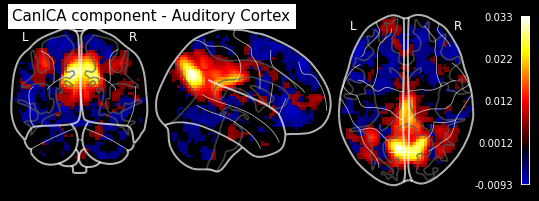
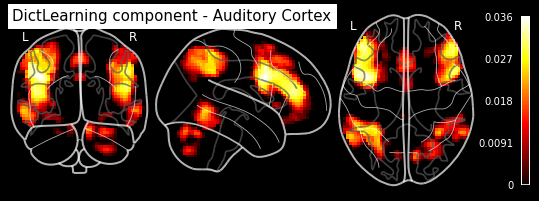
Maps obtained with dictionary leaning are often easier to exploit as they are less noisy than ICA maps, with blobs usually better defined. Typically, smoothing can be lower than when doing ICA. While dictionary learning computation time is comparable to CanICA, obtained atlases have been shown to outperform ICA in a variety of classification tasks.
Extract functional connectome based on dictionary learning components¶
Similar to the very first section of this notebook, we can now take the components from the dictionary learning and compute a correlation matrix between the regions defined by the components.
We will be using nilearn’s RegionExtractor to extract brain connected regions from the dictionary maps. We will be using the automatic thresholding strategy ratio_n_voxels. We use this thresholding strategy to first get foreground information present in the maps and then followed by robust region extraction on foreground information using Random Walker algorithm selected as extractor='local_regions'.
from nilearn.regions import RegionExtractor
extractor = RegionExtractor(dict_learn.components_img_, threshold=0.5,
thresholding_strategy='ratio_n_voxels',
extractor='local_regions', verbose=1,
standardize=True, min_region_size=1350)
Here, we control foreground extraction using parameter threshold=0.5, which represents the expected proportion of voxels included in the regions (i.e. with a non-zero value in one of the maps). If you need to keep more proportion of voxels then threshold should be tweaked according to the maps data.
The parameter min_region_size=1350 mm^3 is to keep the minimum number of extracted regions. We control the small spurious regions size by thresholding in voxel units to adapt well to the resolution of the image. Please see the documentation of nilearn.regions.connected_regions for more details.
extractor.fit()
[RegionExtractor.fit] loading regions from Nifti1Image(
shape=(61, 73, 61, 81),
affine=array([[ -3., 0., 0., 90.],
[ 0., 3., 0., -126.],
[ 0., 0., 3., -72.],
[ 0., 0., 0., 1.]])
)
RegionExtractor(detrend=False, extractor='local_regions', high_pass=None,
low_pass=None,
maps_img=<nibabel.nifti1.Nifti1Image object at 0x7f9d11e51fd0>,
mask_img=None, memory=Memory(location=None), memory_level=0,
min_region_size=1350, smoothing_fwhm=6, standardize=True, t_r=None,
threshold=0.5, thresholding_strategy='ratio_n_voxels', verbose=1)
So how many regions did we extract?
# Total number of regions extracted
n_regions_extracted = extractor.regions_img_.shape[-1]
n_regions_extracted
81
Now, to get the average functional connectome over all subjects we need to compute the correlation matrix for each subject individually and than average those matrices into one.
from nilearn.connectome import ConnectivityMeasure
# Initializing ConnectivityMeasure object with kind='correlation'
connectome_measure = ConnectivityMeasure(kind='correlation')
# Iterate over the subjects and compute correlation matrix for each
correlations = []
for filename, confound in zip(rest_files, confound_files):
timeseries_each_subject = extractor.transform(filename, confounds=confound)
correlation = connectome_measure.fit_transform([timeseries_each_subject])
correlations.append(correlation)
# Get array in good numpy structure
correlations = np.squeeze(correlations)
[RegionExtractor.transform_single_imgs] Loading data from /data/adhd/0010042/0010042_rest_tshift_RPI_voreg_mni.nii.gz
[RegionExtractor.transform_single_imgs] Smoothing images
[RegionExtractor.transform_single_imgs] Extracting region signals
[RegionExtractor.transform_single_imgs] Cleaning extracted signals
[RegionExtractor.transform_single_imgs] Loading data from /data/adhd/0010064/0010064_rest_tshift_RPI_voreg_mni.nii.gz
[RegionExtractor.transform_single_imgs] Smoothing images
[RegionExtractor.transform_single_imgs] Extracting region signals
[RegionExtractor.transform_single_imgs] Cleaning extracted signals
[RegionExtractor.transform_single_imgs] Loading data from /data/adhd/0010128/0010128_rest_tshift_RPI_voreg_mni.nii.gz
[RegionExtractor.transform_single_imgs] Smoothing images
[RegionExtractor.transform_single_imgs] Extracting region signals
[RegionExtractor.transform_single_imgs] Cleaning extracted signals
[RegionExtractor.transform_single_imgs] Loading data from /data/adhd/0021019/0021019_rest_tshift_RPI_voreg_mni.nii.gz
[RegionExtractor.transform_single_imgs] Smoothing images
[RegionExtractor.transform_single_imgs] Extracting region signals
[RegionExtractor.transform_single_imgs] Cleaning extracted signals
[RegionExtractor.transform_single_imgs] Loading data from /data/adhd/0027018/0027018_rest_tshift_RPI_voreg_mni.nii.gz
[RegionExtractor.transform_single_imgs] Smoothing images
[RegionExtractor.transform_single_imgs] Extracting region signals
[RegionExtractor.transform_single_imgs] Cleaning extracted signals
[RegionExtractor.transform_single_imgs] Loading data from /data/adhd/0027034/0027034_rest_tshift_RPI_voreg_mni.nii.gz
[RegionExtractor.transform_single_imgs] Smoothing images
[RegionExtractor.transform_single_imgs] Extracting region signals
[RegionExtractor.transform_single_imgs] Cleaning extracted signals
[RegionExtractor.transform_single_imgs] Loading data from /data/adhd/0027037/0027037_rest_tshift_RPI_voreg_mni.nii.gz
[RegionExtractor.transform_single_imgs] Smoothing images
[RegionExtractor.transform_single_imgs] Extracting region signals
[RegionExtractor.transform_single_imgs] Cleaning extracted signals
[RegionExtractor.transform_single_imgs] Loading data from /data/adhd/1517058/1517058_rest_tshift_RPI_voreg_mni.nii.gz
[RegionExtractor.transform_single_imgs] Smoothing images
[RegionExtractor.transform_single_imgs] Extracting region signals
[RegionExtractor.transform_single_imgs] Cleaning extracted signals
[RegionExtractor.transform_single_imgs] Loading data from /data/adhd/1562298/1562298_rest_tshift_RPI_voreg_mni.nii.gz
[RegionExtractor.transform_single_imgs] Smoothing images
[RegionExtractor.transform_single_imgs] Extracting region signals
[RegionExtractor.transform_single_imgs] Cleaning extracted signals
[RegionExtractor.transform_single_imgs] Loading data from /data/adhd/2497695/2497695_rest_tshift_RPI_voreg_mni.nii.gz
[RegionExtractor.transform_single_imgs] Smoothing images
[RegionExtractor.transform_single_imgs] Extracting region signals
[RegionExtractor.transform_single_imgs] Cleaning extracted signals
[RegionExtractor.transform_single_imgs] Loading data from /data/adhd/2950754/2950754_rest_tshift_RPI_voreg_mni.nii.gz
[RegionExtractor.transform_single_imgs] Smoothing images
[RegionExtractor.transform_single_imgs] Extracting region signals
[RegionExtractor.transform_single_imgs] Cleaning extracted signals
[RegionExtractor.transform_single_imgs] Loading data from /data/adhd/3007585/3007585_rest_tshift_RPI_voreg_mni.nii.gz
[RegionExtractor.transform_single_imgs] Smoothing images
[RegionExtractor.transform_single_imgs] Extracting region signals
[RegionExtractor.transform_single_imgs] Cleaning extracted signals
[RegionExtractor.transform_single_imgs] Loading data from /data/adhd/3520880/3520880_rest_tshift_RPI_voreg_mni.nii.gz
[RegionExtractor.transform_single_imgs] Smoothing images
[RegionExtractor.transform_single_imgs] Extracting region signals
[RegionExtractor.transform_single_imgs] Cleaning extracted signals
[RegionExtractor.transform_single_imgs] Loading data from /data/adhd/3994098/3994098_rest_tshift_RPI_voreg_mni.nii.gz
[RegionExtractor.transform_single_imgs] Smoothing images
[RegionExtractor.transform_single_imgs] Extracting region signals
[RegionExtractor.transform_single_imgs] Cleaning extracted signals
[RegionExtractor.transform_single_imgs] Loading data from /data/adhd/4134561/4134561_rest_tshift_RPI_voreg_mni.nii.gz
[RegionExtractor.transform_single_imgs] Smoothing images
[RegionExtractor.transform_single_imgs] Extracting region signals
[RegionExtractor.transform_single_imgs] Cleaning extracted signals
[RegionExtractor.transform_single_imgs] Loading data from /data/adhd/6115230/6115230_rest_tshift_RPI_voreg_mni.nii.gz
[RegionExtractor.transform_single_imgs] Smoothing images
[RegionExtractor.transform_single_imgs] Extracting region signals
[RegionExtractor.transform_single_imgs] Cleaning extracted signals
[RegionExtractor.transform_single_imgs] Loading data from /data/adhd/8409791/8409791_rest_tshift_RPI_voreg_mni.nii.gz
[RegionExtractor.transform_single_imgs] Smoothing images
[RegionExtractor.transform_single_imgs] Extracting region signals
[RegionExtractor.transform_single_imgs] Cleaning extracted signals
[RegionExtractor.transform_single_imgs] Loading data from /data/adhd/8697774/8697774_rest_tshift_RPI_voreg_mni.nii.gz
[RegionExtractor.transform_single_imgs] Smoothing images
[RegionExtractor.transform_single_imgs] Extracting region signals
[RegionExtractor.transform_single_imgs] Cleaning extracted signals
[RegionExtractor.transform_single_imgs] Loading data from /data/adhd/9744150/9744150_rest_tshift_RPI_voreg_mni.nii.gz
[RegionExtractor.transform_single_imgs] Smoothing images
[RegionExtractor.transform_single_imgs] Extracting region signals
[RegionExtractor.transform_single_imgs] Cleaning extracted signals
[RegionExtractor.transform_single_imgs] Loading data from /data/adhd/9750701/9750701_rest_tshift_RPI_voreg_mni.nii.gz
[RegionExtractor.transform_single_imgs] Smoothing images
[RegionExtractor.transform_single_imgs] Extracting region signals
[RegionExtractor.transform_single_imgs] Cleaning extracted signals
Now that this is all computed, we can take the average correlation matrix and plot it:
# Computing the mean correlation matrix
mean_correlations = np.mean(correlations, axis=0)
# Plot the average correlation matrix
title = 'Correlation between %d regions' % n_regions_extracted
plotting.plot_matrix(mean_correlations, vmax=1, vmin=-1, colorbar=True,
labels=['IC %0d' % i for i in range(n_regions_extracted)],
title=title, reorder=True)
/opt/miniconda-latest/envs/neuro/lib/python3.7/site-packages/nilearn/plotting/matrix_plotting.py:17: MatplotlibDeprecationWarning:
The inverse_transformed function was deprecated in Matplotlib 3.3 and will be removed two minor releases later. Use transformed(transform.inverted()) instead.
ax.figure.transFigure).width
/opt/miniconda-latest/envs/neuro/lib/python3.7/site-packages/nilearn/plotting/matrix_plotting.py:25: MatplotlibDeprecationWarning:
The inverse_transformed function was deprecated in Matplotlib 3.3 and will be removed two minor releases later. Use transformed(transform.inverted()) instead.
ax.figure.transFigure).height
<matplotlib.image.AxesImage at 0x7f9d11a629d0>
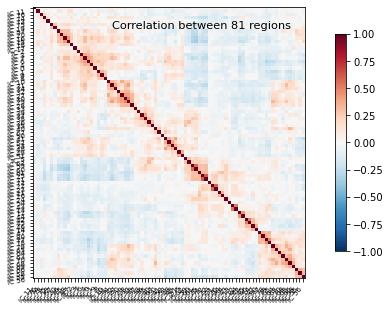
And as a last step, let’s plot the average function connectome, based on the dictionary learning components also on the glass brain.
For this to work, we first need to find the center of the regions. Luckily nilearn provides a nice function, called find_xyz_cut_coords that does exactly that.
# Find the center of the regions with find_xyz_cut_coords
coords_connectome = [plotting.find_xyz_cut_coords(img)
for img in image.iter_img(extractor.regions_img_)]
# Plot the functional connectome on the glass brain
plotting.plot_connectome(mean_correlations, coords_connectome,
edge_threshold='95%', title=title)
<nilearn.plotting.displays.OrthoProjector at 0x7f9d12196110>
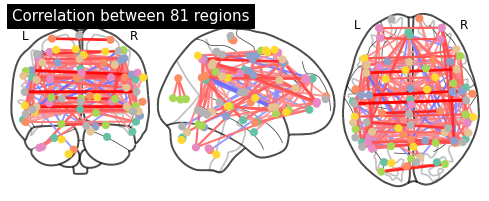
plotting.view_connectome(mean_correlations, coords_connectome, edge_cmap='bwr',
symmetric_cmap=True, linewidth=6.0, node_size=10.0)
